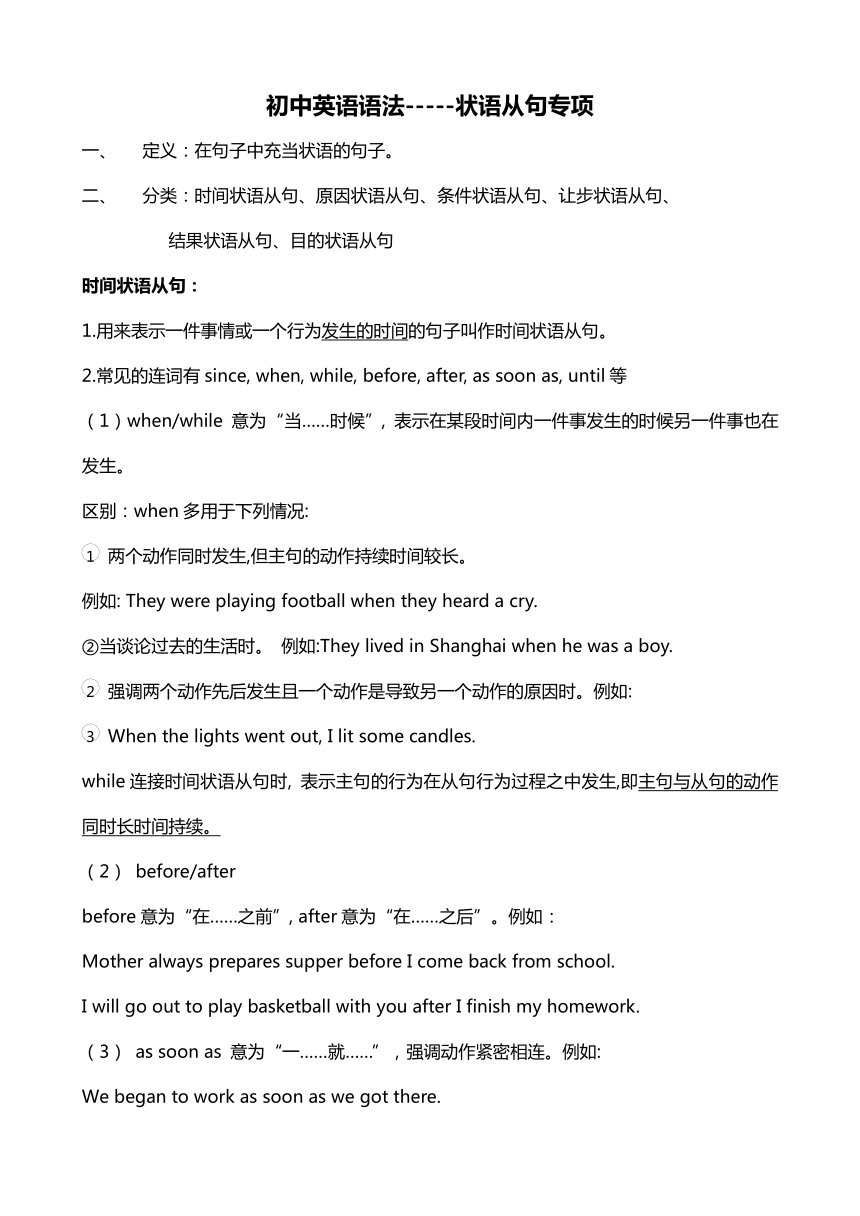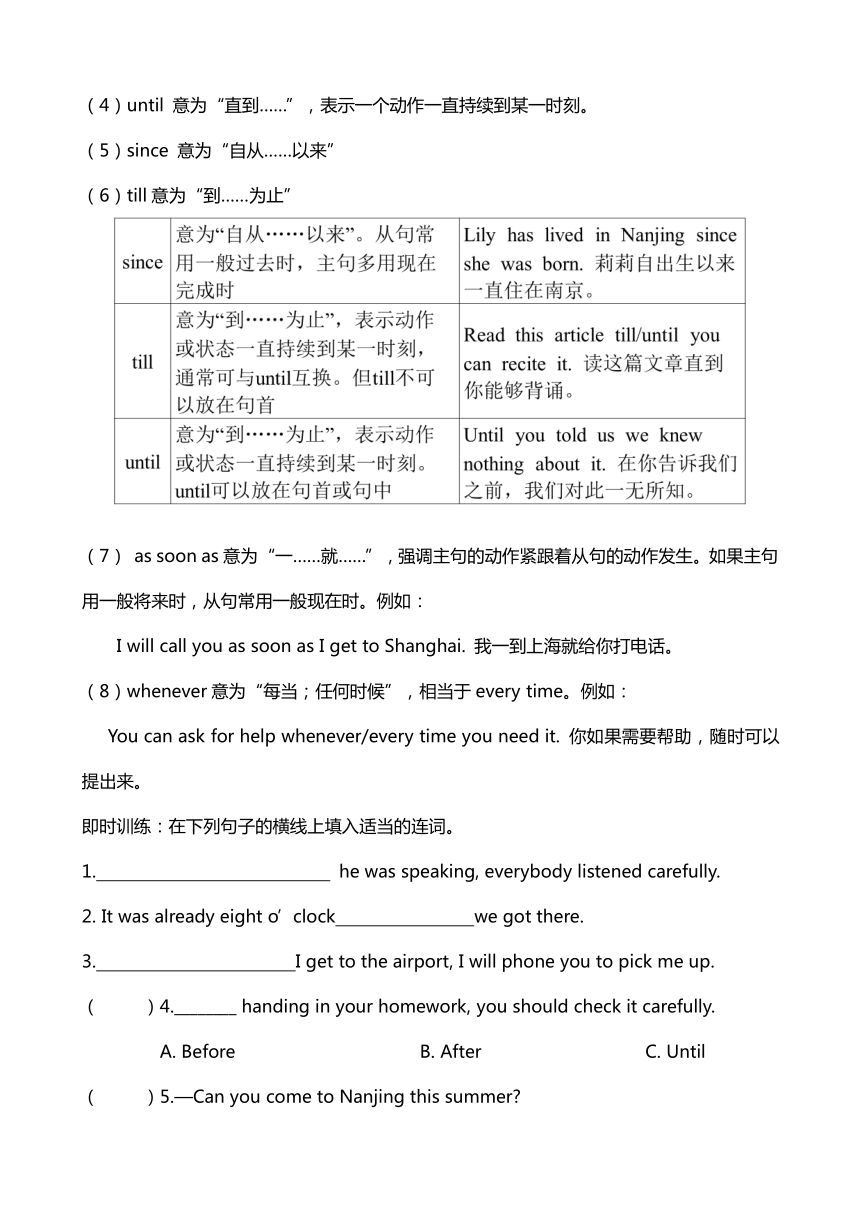Unit 4-7 Grammar状语从句学案 2024-2025学年牛津译林版九年级英语上册
文档属性
| 名称 | Unit 4-7 Grammar状语从句学案 2024-2025学年牛津译林版九年级英语上册 |  | |
| 格式 | docx | ||
| 文件大小 | 117.1KB | ||
| 资源类型 | 教案 | ||
| 版本资源 | 牛津译林版 | ||
| 科目 | 英语 | ||
| 更新时间 | 2024-07-10 17:20:24 | ||
图片预览


文档简介
初中英语语法-----状语从句专项
定义:在句子中充当状语的句子。
分类:时间状语从句、原因状语从句、条件状语从句、让步状语从句、
结果状语从句、目的状语从句
时间状语从句:
1.用来表示一件事情或一个行为发生的时间的句子叫作时间状语从句。
2.常见的连词有since, when, while, before, after, as soon as, until等
(1)when/while 意为“当……时候”, 表示在某段时间内一件事发生的时候另一件事也在发生。
区别:when多用于下列情况:
两个动作同时发生,但主句的动作持续时间较长。
例如: They were playing football when they heard a cry.
②当谈论过去的生活时。 例如:They lived in Shanghai when he was a boy.
强调两个动作先后发生且一个动作是导致另一个动作的原因时。例如:
When the lights went out, I lit some candles.
while连接时间状语从句时, 表示主句的行为在从句行为过程之中发生,即主句与从句的动作同时长时间持续。
(2) before/after
before意为“在……之前”, after意为“在……之后”。例如:
Mother always prepares supper before I come back from school.
I will go out to play basketball with you after I finish my homework.
(3) as soon as 意为“一……就……”,强调动作紧密相连。例如:
We began to work as soon as we got there.
(4)until 意为“直到……”,表示一个动作一直持续到某一时刻。
(5)since 意为“自从……以来”
(6)till意为“到……为止”
(7) as soon as意为“一……就……”,强调主句的动作紧跟着从句的动作发生。如果主句用一般将来时,从句常用一般现在时。例如:
I will call you as soon as I get to Shanghai. 我一到上海就给你打电话。
(8)whenever意为“每当;任何时候”,相当于every time。例如:
You can ask for help whenever/every time you need it. 你如果需要帮助,随时可以提出来。
即时训练:在下列句子的横线上填入适当的连词。
1. he was speaking, everybody listened carefully.
2. It was already eight o’clock we got there.
3. I get to the airport, I will phone you to pick me up.
( )4.________ handing in your homework, you should check it carefully.
A. Before B. After C. Until
( )5.—Can you come to Nanjing this summer
—OK. I will leave for Nanjing ________ the summer holiday starts.
whether B.as soon as C. if
原因状语从句
原因状语从句常用because, since, as等词引导,用来引出事物发生的原因。
He came to school late this morning because his bike was broken. 由于自行车坏了,他今天早晨上学迟到了
结果状语从句 :结果状语从句常用so, so… that, such… that等来引导。例如:
He didn’t work hard so he didn’t pass the exam.他学习不努力,结果没通过考试。
( )1. China’s Got Talent is interesting many people like watching it.
A. too; to B. enough; to C. so; that
目的状语从句
目的状语从句常用so, in order that, so that等来引导,意为“目的是……”,后面常接can, could, will, would等词。例如:
He got up early so that he could catch the first bus.他早起为的是能赶上第一趟公共汽车。
If引导的条件状语从句
if 意为“如果;假如”,表示在某种条件下某事将会发生。if引导的条件状语从句可以放在主句的前面,也可位于主句的后面。当放在主句前面时,通常要用逗号隔开。if引导的条件状语从句和主句的时态搭配情况有以下几种:
(1) 如果主句是一般将来时,从句则用一般现在时来表示将来。例如:
If it is fine tomorrow, we will go hiking. 如果明天天气好,我们要去远足。
(2)如果主句是祈使句,从句要用一般现在时。例如:
Wear warm clothes if you want to go skating. 如果你想去溜冰,穿上暖和的衣服。
(3)如果主句谓语含有must、may、can 等情态动词,从句也用一般现在时。例如:
You can play computer games if your homework is finished. 如果你的作业完成了,你可以玩电脑游戏。
unless 引导的条件状语从句
unless 意为“除非;如果不”, unless 引导的条件状语从句表示强烈的否定。在含有unless引导的条件状语从句的复合句中,若主句为一般将来时,主句为祈使句或主句谓语含有must、may、can 等情态动词,从句用一般现在时。例如:
You will fail this exam unless you study hard.如果你不努力学习这次考试你将会不及格。
即时训练:单项选择
( )1.I believe that ________ Kate is free, she will go to the concert with me.
A.though B.if C.unless
( )2.—Is your account safe
—Yes, even my father can’t use it ________ I tell him the password.
A.when B.if C.unless
( )3.—Will you go to Sam’s birthday party if he ________ you
—Of course. But I’m not sure if he ________ me. I haven’t received his invitation yet.
A.invites; invites B.will invite; invites C.invites; will invite
让步状语从句
让步状语从句表示即便出现从句中的情况,主句动作仍然会发生。常用连词although或though来引导让步状语从句,两者均意为“尽管,虽然”。在一般情况下,两者可以互换。although比though正式,though常用于口语中。though/although引导的让步状语从句不能与but连用。
( )1. they were quite tired, they continued working.
A. Though; \ B. Although; but C. Because; \
( )2. my cousin is very young, she can help with housework.
A. Once; \ B. Though; but C. Although; \
定义:在句子中充当状语的句子。
分类:时间状语从句、原因状语从句、条件状语从句、让步状语从句、
结果状语从句、目的状语从句
时间状语从句:
1.用来表示一件事情或一个行为发生的时间的句子叫作时间状语从句。
2.常见的连词有since, when, while, before, after, as soon as, until等
(1)when/while 意为“当……时候”, 表示在某段时间内一件事发生的时候另一件事也在发生。
区别:when多用于下列情况:
两个动作同时发生,但主句的动作持续时间较长。
例如: They were playing football when they heard a cry.
②当谈论过去的生活时。 例如:They lived in Shanghai when he was a boy.
强调两个动作先后发生且一个动作是导致另一个动作的原因时。例如:
When the lights went out, I lit some candles.
while连接时间状语从句时, 表示主句的行为在从句行为过程之中发生,即主句与从句的动作同时长时间持续。
(2) before/after
before意为“在……之前”, after意为“在……之后”。例如:
Mother always prepares supper before I come back from school.
I will go out to play basketball with you after I finish my homework.
(3) as soon as 意为“一……就……”,强调动作紧密相连。例如:
We began to work as soon as we got there.
(4)until 意为“直到……”,表示一个动作一直持续到某一时刻。
(5)since 意为“自从……以来”
(6)till意为“到……为止”
(7) as soon as意为“一……就……”,强调主句的动作紧跟着从句的动作发生。如果主句用一般将来时,从句常用一般现在时。例如:
I will call you as soon as I get to Shanghai. 我一到上海就给你打电话。
(8)whenever意为“每当;任何时候”,相当于every time。例如:
You can ask for help whenever/every time you need it. 你如果需要帮助,随时可以提出来。
即时训练:在下列句子的横线上填入适当的连词。
1. he was speaking, everybody listened carefully.
2. It was already eight o’clock we got there.
3. I get to the airport, I will phone you to pick me up.
( )4.________ handing in your homework, you should check it carefully.
A. Before B. After C. Until
( )5.—Can you come to Nanjing this summer
—OK. I will leave for Nanjing ________ the summer holiday starts.
whether B.as soon as C. if
原因状语从句
原因状语从句常用because, since, as等词引导,用来引出事物发生的原因。
He came to school late this morning because his bike was broken. 由于自行车坏了,他今天早晨上学迟到了
结果状语从句 :结果状语从句常用so, so… that, such… that等来引导。例如:
He didn’t work hard so he didn’t pass the exam.他学习不努力,结果没通过考试。
( )1. China’s Got Talent is interesting many people like watching it.
A. too; to B. enough; to C. so; that
目的状语从句
目的状语从句常用so, in order that, so that等来引导,意为“目的是……”,后面常接can, could, will, would等词。例如:
He got up early so that he could catch the first bus.他早起为的是能赶上第一趟公共汽车。
If引导的条件状语从句
if 意为“如果;假如”,表示在某种条件下某事将会发生。if引导的条件状语从句可以放在主句的前面,也可位于主句的后面。当放在主句前面时,通常要用逗号隔开。if引导的条件状语从句和主句的时态搭配情况有以下几种:
(1) 如果主句是一般将来时,从句则用一般现在时来表示将来。例如:
If it is fine tomorrow, we will go hiking. 如果明天天气好,我们要去远足。
(2)如果主句是祈使句,从句要用一般现在时。例如:
Wear warm clothes if you want to go skating. 如果你想去溜冰,穿上暖和的衣服。
(3)如果主句谓语含有must、may、can 等情态动词,从句也用一般现在时。例如:
You can play computer games if your homework is finished. 如果你的作业完成了,你可以玩电脑游戏。
unless 引导的条件状语从句
unless 意为“除非;如果不”, unless 引导的条件状语从句表示强烈的否定。在含有unless引导的条件状语从句的复合句中,若主句为一般将来时,主句为祈使句或主句谓语含有must、may、can 等情态动词,从句用一般现在时。例如:
You will fail this exam unless you study hard.如果你不努力学习这次考试你将会不及格。
即时训练:单项选择
( )1.I believe that ________ Kate is free, she will go to the concert with me.
A.though B.if C.unless
( )2.—Is your account safe
—Yes, even my father can’t use it ________ I tell him the password.
A.when B.if C.unless
( )3.—Will you go to Sam’s birthday party if he ________ you
—Of course. But I’m not sure if he ________ me. I haven’t received his invitation yet.
A.invites; invites B.will invite; invites C.invites; will invite
让步状语从句
让步状语从句表示即便出现从句中的情况,主句动作仍然会发生。常用连词although或though来引导让步状语从句,两者均意为“尽管,虽然”。在一般情况下,两者可以互换。although比though正式,though常用于口语中。though/although引导的让步状语从句不能与but连用。
( )1. they were quite tired, they continued working.
A. Though; \ B. Although; but C. Because; \
( )2. my cousin is very young, she can help with housework.
A. Once; \ B. Though; but C. Although; \
